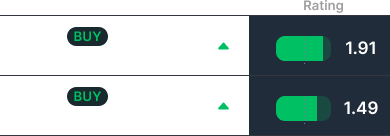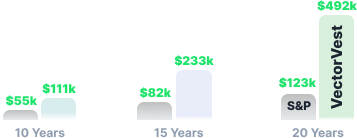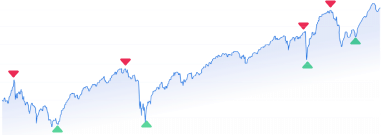While many view stocks falling as red flags to avoid, others view them as hidden gems, ripe for the picking. These declining stocks can be undervalued assets on the verge of a rebound, offering savvy investors a chance to maximize profits.
However, the risk of ‘catching a falling knife’ – investing in stocks that continue to plummet – looms large, posing a challenge even for seasoned investors. We’re going to help you avoid this in our guide to finding falling stocks to buy today.
You’ll discover the secrets to identifying undervalued stocks falling in price that are undervalued and ready to reverse. We’ll show you not just how to analyze a stock using traditional techniques but also how to streamline the process through VectorVest: an innovative stock forecasting software that helps you stay ahead of the curve.
Why Are Stocks Falling Today? Common Causes for Unexplained Drops in Price
First, let’s talk about why stocks are falling today. It seems that prices are down across the board – but what’s the cause for this? There are two things that affect stock price: market forces and specific company insights.
Market Dynamics and External Factors
Market dynamics play a significant role in stock price movements. Economic indicators like changes in interest rates, inflation data, and employment rates can influence investor sentiment and affect the entire market.
For instance, an interest rate hike can lead to a sell-off in stocks, as higher borrowing costs might dampen corporate profits.
Global events also have a substantial impact. Political instability, geopolitical tensions, or a global health crisis can trigger market-wide sell-offs.
Investors often react to such news with a risk-off approach, leading to declines in stock prices across various sectors. The interconnectedness of global markets means that an event in one part of the world can have ripple effects internationally.
Learn more about market forces in our blog including market sentiment or what happens to stocks in a recession.
Company-Specific Reasons for Price Drops
On a micro level, individual company issues can lead to stock price declines. Poor earnings reports are a common trigger. If a company fails to meet Wall Street’s expectations, its stock price can take a hit. This reaction is often immediate, reflecting the market’s sensitivity to financial performance.
Management decisions and changes can also influence stock prices. Leadership changes, mergers and acquisitions, or strategic shifts can lead to uncertainty among investors, resulting in stock price volatility.
Additionally, industry-specific developments, such as regulatory changes or shifts in consumer preferences, can impact companies within that sector, causing stock prices to drop.
Should You Buy Falling Stocks? The Risks of Catching a Falling Knife
VectorVest advocates for buying safe, undervalued stocks that are rising in price. So, let’s talk about the risks of falling knife stocks and determine if this speculative approach to investing is worth incorporating into your trading strategy.
The Peril of Catching a Falling Knife
Investing in falling knife stocks is risky because the reasons for their decline can be complex and not always immediately apparent.
The peril lies in the uncertainty: Is the stock undervalued and poised for a rebound, or is it on a downward trajectory due to fundamental issues within the company or industry?
Misjudging this can lead to significant losses, as the stock might continue to fall even after purchase. So many investors have experienced the despair of buying a stock that’s plummeted in value with the expectation that it will turn around in the near term – only for the stock to never recover.
Assessing the Risk-Reward Balance
Assessing the risk-reward balance before investing in a falling knife stock is vital. This involves a thorough analysis of why the stock is falling and whether these reasons are temporary or indicative of deeper problems. So, should I buy stocks when they are low or high?
Investors need to consider if the potential upside of a rebound outweighs the risk of further decline. This assessment should be based on solid research and a clear understanding of the factors affecting the stock’s performance.
Strategies to Mitigate Risks
One effective strategy is to set clear entry and exit points. This approach involves deciding in advance the price at which to buy the stock and the point at which to sell, whether to realize profits or cut losses.
Another strategy is diversification, which involves spreading investments across various stocks or sectors to mitigate the risk of a significant loss from a single stock.
Investors can also look for signs of stabilization in the stock’s price, indicating that the worst of the decline may be over. Swing trading tools like VectorVest can be invaluable here, providing data-driven insights and analytics to help investors make informed decisions. More on that later.
How to Find Falling Stocks to Buy That Are Poised to Rebound
Finding falling stocks that are poised to rebound requires a multifaceted approach, combining fundamental analysis with technical analysis along with sector evaluation.
This strategy involves identifying undervalued stocks, understanding the reasons behind their price drops, and using technical analysis to predict potential reversals. Advanced tools and stock screeners also play a crucial role in this process. Here’s what you need to know…
Identifying Undervalued Stocks with Strong Fundamentals
The search for rebound candidates starts with identifying undervalued stocks. These are shares trading below their intrinsic value, often due to market overreactions.
Fundamental analysis is key here. Assess the company’s financial health, including its earnings, revenue growth, debt levels, and cash flow. Look for companies with strong fundamentals that are likely to withstand market volatility.
Analyzing financial ratios such as Price-to-Earnings (P/E), Price-to-Book (P/B), and Debt-to-Equity can provide insights into the stock’s true value compared to its current market price.
In VectorVest, you’ll just rely on one simple metric: Relative Value (RV). This proprietary stock indicator compares long-term price appreciation potential (based on a 3-year price projection) with AAA corporate bond rates and risk.
It’s a much better indicator than a simple comparison of price to value alone. Learn more about how to do fundamental analysis of stocks in our blog. In the meantime, let’s talk about determining what caused the drop before buying.
Determining the Cause Behind the Drop
Understanding why a stock is falling is critical. Is the decline due to company-specific issues like poor earnings or management changes, or is it part of a broader market downturn?
Company-specific problems might indicate a riskier investment, whereas broader market reactions could present buying opportunities for fundamentally strong stocks.
Investigate news, earnings reports, and industry trends to discern the reasons behind the drop. This analysis can help in distinguishing temporary setbacks from long-term issues.
Using Technical Analysis to Identify Potential Reversals
If you don’t see any red flags in vetting what caused a drop, you can add a stock to your watchlist and start looking for trading patterns that indicate a reversal is on the horizon. This is where using the best indicators for swing trading comes in.
Look for technical indicators that suggest a stock might be oversold and ready for a rebound. Tools like Relative Strength Index (RSI), Moving Averages, and Bollinger Bands can be instrumental in identifying potential reversal points.
Chart patterns such as double bottoms or bullish engulfing can also signal a change in sentiment and a possible uptrend.
We have insights into the best candlestick patterns for swing trading, best MACD settings for swing trading, best stochastic settings for swing trading, and even the best moving average for swing trading.
But again, you can simplify the process of how to pick a stock with VectorVest’s proprietary ratings, in this case, relative timing (RT). This rating speaks to a stock’s price trend, which is why it’s so powerful in identifying reversals.
An RT rating above 1.00 indicates a positive price trend, and vice versa. As a falling RT rating starts to reverse, it indicates that a negative price trend is subsiding and a more favorable price trend is taking over. This can help you avoid falling knife stocks.
Sector and Industry Analysis
Examining the sector or industry of the falling stock is essential. Some sectors rebound faster than others after a market downturn.
Analyzing industry health, regulatory changes, and technological advancements can give clues about potential sector rebounds. Comparing the performance of a stock with its peers within the same sector can also indicate whether its fall is an outlier or a sector-wide trend.
Utilizing Advanced Tools and Screeners
Want to bring falling stocks to buy to your screen on a daily basis? This is where the best swing trade alert service plays a pivotal role in saving you time and stress in your trading strategy. You never have to go out and find your next opportunity!
Platforms like VectorVest provide comprehensive stock analysis, integrating both fundamental and technical data. VectorVest’s tools can quickly filter stocks based on specified criteria such as value, safety, and timing, helping investors identify potential rebound candidates efficiently.
Screeners can be set to alert on specific criteria, such as a certain RSI level or a moving average crossover, signaling a potential investment opportunity. This real-time data is invaluable for investors looking to capitalize on short-term market movements.
Learn more about how to scan stocks in our blog. But for now, it’s time to discover firsthand what a difference the best platforms for swing trading can make in helping you identify and evaluate falling stocks to buy…
Finding Falling Stocks to Buy Today Becomes Effortless With VectorVest!
VectorVest revolutionizes the process of finding falling stocks poised for a rebound, making what was once a complex task both effortless and efficient. Our sophisticated stock analysis and portfolio management system analyzes, ranks, and graphs over 16,000 stocks daily.
What sets VectorVest apart is its unique blend of technical analysis vs fundamental analysis. As we touched on throughout this guide, the system evaluates stocks based on three key metrics: value, safety, and timing (VST).
Each stock is assigned a VST rating, simplifying the complex data into easily understandable indicators. This helps investors quickly identify undervalued stocks with strong rebound potential.
VectorVest’s real-time market analysis and trend forecasting capabilities are pivotal in spotting falling knife stocks that are likely to recover. The platform not only identifies these stocks but also provides clear buy, sell, or hold signals. This guidance is crucial for investors looking to capitalize on market opportunities without getting caught in the peril of catching a falling knife.
The best part is that VectorVest doesn’t just help you identify opportunities. It helps you execute them with confidence, showing you the best time to buy stocks along with when to sell a stock for profit.
Whether you’re wondering how to select stocks for swing trading or seeking guidance on stocks to trade options, VectorVest can empower you to win more trades with less work. So, why not boost your swing trading success rate and trading profits by subscribing to the best stock analysis app today?
We’re confident you’ll agree this is an essential tool in your arsenal once you see it in action. But, you don’t have to take our word for it – you can get a free stock analysis today.
Parting Thoughts on Falling Knife Stocks
Investing in falling knife stocks is a high-risk, high-reward venture that requires careful analysis and timing. While these stocks present potential opportunities for significant gains, they also carry the risk of continued decline.
Successful investment in such stocks demands a balanced approach, combining thorough research, understanding market trends, and utilizing technical indicators. With the right tools and strategies, you can navigate these challenging waters and potentially turn market volatility to your advantage.
While investing in a down market is always inherently risky, our stock advisory helps mitigate your concerns and sets you up for success in any market conditions! This is why you don’t need a financial advisor. VectorVest is a fraction of the cost, always available to guide you in the right direction, and free of biases, human error, and emotion.
Whether you’re looking for the best swing trading stocks or good stocks for beginners, you can trust that Vectorvest will enhance your trading strategy. In fact, you can get started risk-free today for 30 days for just $0.99!
What you should do next…
- Get our latest blogs delivered right to your inbox, subscribe to our newsletter.
- The market moves fast! Get our most current evaluation of this stock with our FREE stock analysis tool.
- Looking for stock picks? Not sure if now is the right time to buy/sell? For a limited time, enjoy the full benefits of a 30-day subscription to VectorVest for only [offer_txt] (usually up to [saving_txt]/month) . Get access to our full list of screeners showcasing our top stock picks that tell you exactly what to buy, when to buy, and when to sell.












